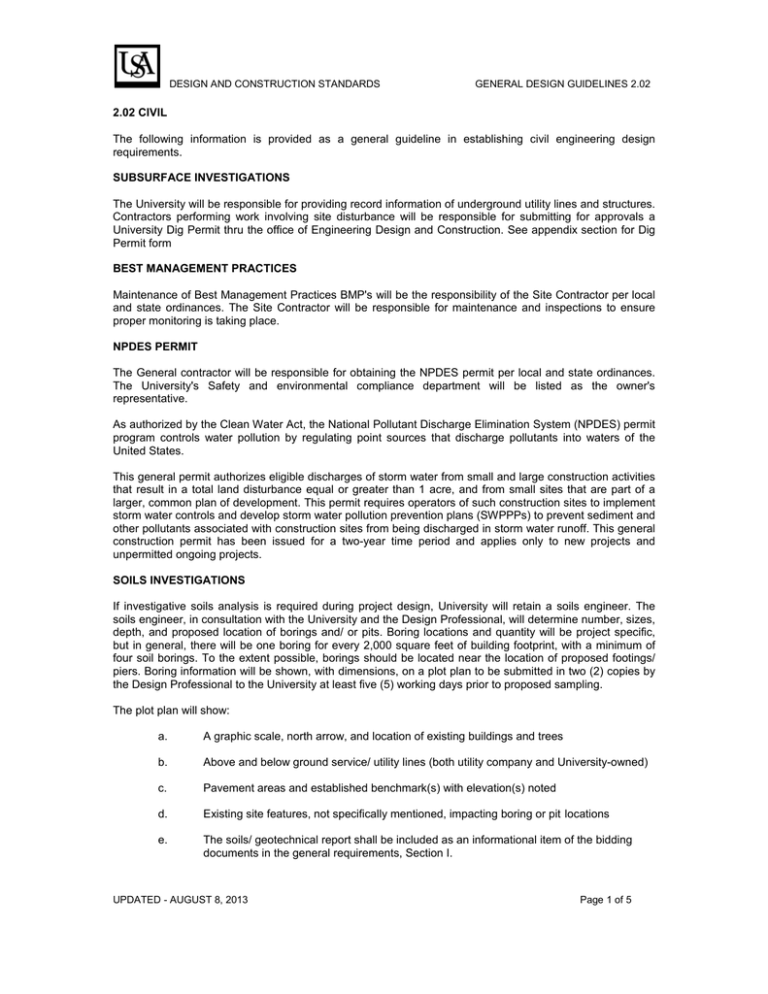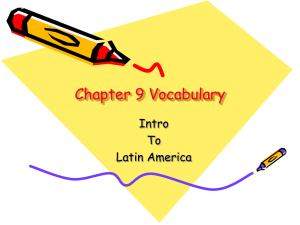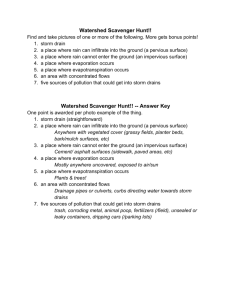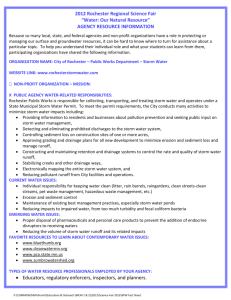Document 11171633
advertisement

DESIGN AND CONSTRUCTION STANDARDS GENERAL DESIGN GUIDELINES 2.02 2.02 CIVIL The following information is provided as a general guideline in establishing civil engineering design requirements. SUBSURFACE INVESTIGATIONS The University will be responsible for providing record information of underground utility lines and structures. Contractors performing work involving site disturbance will be responsible for submitting for approvals a University Dig Permit thru the office of Engineering Design and Construction. See appendix section for Dig Permit form BEST MANAGEMENT PRACTICES Maintenance of Best Management Practices BMP's will be the responsibility of the Site Contractor per local and state ordinances. The Site Contractor will be responsible for maintenance and inspections to ensure proper monitoring is taking place. NPDES PERMIT The General contractor will be responsible for obtaining the NPDES permit per local and state ordinances. The University's Safety and environmental compliance department will be listed as the owner's representative. As authorized by the Clean Water Act, the National Pollutant Discharge Elimination System (NPDES) permit program controls water pollution by regulating point sources that discharge pollutants into waters of the United States. This general permit authorizes eligible discharges of storm water from small and large construction activities that result in a total land disturbance equal or greater than 1 acre, and from small sites that are part of a larger, common plan of development. This permit requires operators of such construction sites to implement storm water controls and develop storm water pollution prevention plans (SWPPPs) to prevent sediment and other pollutants associated with construction sites from being discharged in storm water runoff. This general construction permit has been issued for a two-year time period and applies only to new projects and unpermitted ongoing projects. SOILS INVESTIGATIONS If investigative soils analysis is required during project design, University will retain a soils engineer. The soils engineer, in consultation with the University and the Design Professional, will determine number, sizes, depth, and proposed location of borings and/ or pits. Boring locations and quantity will be project specific, but in general, there will be one boring for every 2,000 square feet of building footprint, with a minimum of four soil borings. To the extent possible, borings should be located near the location of proposed footings/ piers. Boring information will be shown, with dimensions, on a plot plan to be submitted in two (2) copies by the Design Professional to the University at least five (5) working days prior to proposed sampling. The plot plan will show: a. A graphic scale, north arrow, and location of existing buildings and trees b. Above and below ground service/ utility lines (both utility company and University-owned) c. Pavement areas and established benchmark(s) with elevation(s) noted d. Existing site features, not specifically mentioned, impacting boring or pit locations e. The soils/ geotechnical report shall be included as an informational item of the bidding documents in the general requirements, Section I. UPDATED - AUGUST 8, 2013 Page 1 of 5 DESIGN AND CONSTRUCTION STANDARDS GENERAL DESIGN GUIDELINES 2.02 LANDSCAPING Preservation of existing trees and landscaping will be a primary consideration. Each capital project will provide the irrigation system and grassing. The University will provide the design, material and labor for mulching and plant material. On all capital projects, an irrigation design shall be provided to the owner for review and approval. Irrigation systems will be designed to tie into the University well water system. Finished lawn areas will have a finished slope no steeper than one (1) foot vertically to three (3) feet horizontally. Steeper areas will be covered with ground covers or modified with walls or other treatments. Specific treatments will be identified for project limit lines or edges. IRRIGATION SPECIFICATIONS ROADWAYS, PARKING LOTS, AND WALKWAYS All curbs and sidewalks will be Portland cement concrete with a fibercrete additive. Pavements shall be designed to accommodate the design vehicle for the pavements use. The minimum lane width shall be 10-feet, excluding curb and shy distance (concrete pavements), curb and gutter (asphalt pavements), or striping. Curve radii and intersection radii shall accommodate the design vehicle’s design speed and turning movements. Paved walks less than eight feet wide will be designed with a cross slope of two percent to facilitate drainage. Walks equal to or greater than eight feet wide will have a minimum slope of one percent. It is desired to maintain positive drainage away form walks so surface water does not cross them. All sidewalks will have a minimum width of 6’. Minimum depth to be 6". Where a sidewalk abuts a road or driveway, minimum width to be 10’. Walks adjacent to roads or driveways will not have grass strips between sidewalk and road or driveway, unless a minimum 8’ grass strip can be provided. A medium broom finish will be applied perpendicular to traffic flow. All brooming directions will be shown on the drawings and described in the specifications. All accessible parking spaces shall be “universal spaces.” Parking spaces, other than disabled, shall be 8.5’ in width. No compact car spaces will be permitted. Locations where a parking lot abuts to lawn areas, a mowing strip will be incorporated into the design of the parking lot. A mowing strip is a strip of pavement, 24” in width, on the lawn side of the curb or parking bumpers allowing the lawn to be mowed while parking spaces are occupied. Preferred material for sidewalks, ramps, and other paved, exterior walking surfaces is concrete. All materials must be slip resistant. All sidewalks leading up to a vehicular roadway or route shall have a truncated dome installed per ADA Accessibility Guidelines. The truncated dome shall be Armor-Tile, color: Colonial Red. Design shall be in general accordance with AASHTO “GREEN BOOK” – A Policy on Geometric Design of Highways and Streets, latest edition. Exceptions will be allowed with USA approval where context-sensitive design is warranted. TEMPORARY TRAFFIC CONTROL Temporary traffic control shall be in accordance with the Manual on Uniform Traffic Control Devices (MUTDC) Part 6: Temporary Traffic Control (current version). Closures of streets and rerouting of traffic should be coordinated with the Campus police department and the Safety and Environmental Compliance department thru the University Project Manager. Project Contractors to provide signs and flag men for traffic control. UPDATED - AUGUST 8, 2013 Page 2 of 5 DESIGN AND CONSTRUCTION STANDARDS GENERAL DESIGN GUIDELINES 2.02 PARKING STANDARDS SANITARY SEWERS Sanitary sewers shall be designed in accordance with the standards and requirements of the Alabama Department of Transportation requirements. Sewer systems shall be designed to carry traffic loads in all locations. Sewer piping installation shall include granular bedding with fines and backfill within the pipe envelope, The minimum service line size shall be 6”. The minimum sewer line size shall be 8”. Pre-cast concrete manholes shall comply with ASTM C478 or ASTM C76, Class 3. Cast-in-place manholes shall be detailed in the construction documents. Eccentric covers shall be provided of a material approved by the University. Cleanouts may be used at the end of a sewer line where the distance to the downstream manhole is 150feet or less. Cleanouts are required on service lines outside a building footprint and at horizontal or vertical bends in a service line. The deflection should utilize a wye with the cleanout as an upstream extension of the downstream line’s alignment. Only Ductile Iron will be allowed under slabs. STORM DRAINAGE This section applies to storm water conveyance systems outside the footprint of buildings. Building systems are covered in the Mechanical Systems section. Trunk storm sewers are defined as the primary spine(s) of the piping system and generally carry the flow from more than one site. Storm water systems shall be designed using the actual time of concentration. The worst case of complete development, per the current Campus Master Plan, or current conditions shall be used for calculation of offsite flow. Minimum storm drainage size to be 12” Generally the Rational Formula shall be used for areas under 200-acres. Runoff coefficients shall consider percentage of impervious area and average site grade (slope). Return periods will be 25 years with actual time of concentration (duration) for all building sites, pedestrian malls, streets, quadrangles, and trunk storm sewers. Return periods will be ten (10) years with actual time of concentration (duration) for parking lots, park space, and open areas. PM will establish “return periods” for all other areas. Return period must satisfy governing municipality’s regulations. No ponding is allowed on paved areas. Detention basins shall be labeled on the drawings. Design Professional will compare above return periods with those required by the local municipality. Coordination with municipality may be required and should be reviewed with the PM. Any discrepancies will be discussed with the PM. All buildings and structures will be developed such that no entry of water through entrances, window wells, area ways, basements, drains, etc. will occur during a minimum hundred year storm. Design should maintain positive drainage away from building entrances. UPDATED - AUGUST 8, 2013 Page 3 of 5 DESIGN AND CONSTRUCTION STANDARDS GENERAL DESIGN GUIDELINES 2.02 Connections to building drains shall be designed to prevent surcharge from the storm sewer for the 100-year storm. Sidewalk grade shall be set to prevent surface from collecting and channeling surface drainage. Particular attention will be paid to bicycle and wheelchair safety in the design of storm drainage systems. Grate bars will be placed perpendicular to direction of traffic flow. Grates in pedestrian areas should be sized to avoid catching heels of shoes. Storm drains, except small area drains, shall be reinforced concrete pipe (RCP) conforming to ASTM C76 or AASHTO M170, Class 3 minimum, 12” or larger. HDPE pipe will be allowed by pre approval only and then up to 24" if properly connected and bedded, and only when not located under roadways or parking areas. Yard inlets to be open throat self cleaning "turtle back" design. See appendix drawing (xx). Boxes to be pre cast concrete unless pre approved by the University. Piping for small area drains in courtyards, small yard areas, and building area ways may be 8” or larger. Storm drains less than 36” in diameter shall run on a straight line and grade between structures. Horizontal and vertical bends are permitted in 8” and 10” lines provided a cleanout is included. The deflection should utilize a wye with the cleanout as an upstream extension of the downstream line’s alignment. Comply with the requirements of the National Pollutant Discharge Elimination Systems (NPDES) General Permit No. 2. During the design phase, the design professional must consider and minimize the post construction storm water runoff in order to prevent or minimize water quality impacts and minimize the quantity of storm water runoff. Best management practices related to both water quality and water quantity shall be considered in the design of all projects, and implemented when practical. Best management practices using storm water detention and retention, grass swales, bioretention swales, riparian buffers and proper operation and maintenance of these facilities shall be evaluated for the preferred method to manage storm water. The University Project Manager will coordinate the review of these designs with the University's Safety and Environmental Compliance office and other campus stakeholders. WATER DISTRIBUTION When additional water loads are to be applied to the water distribution systems, the PM and Facilities Management – Utilities and Energy Management unit must be consulted and an evaluation of the load design requirements and available water distribution facilities and operational needs of the Water Plant and water distribution systems must be completed. The anticipated loads will be added to our current hydraulic model and determined what is acceptable, and what changes are required. All piping shall conform to AWWA standards and the requirements of the Alabama DNR. All water meters will be located inside buildings. The material for water distribution systems shall be Class 53 restrained joint cement lined ductile iron pipe wrapped in plastic. Fire hydrants shall be provided in accordance with the requirements of the local fire district or department. Hydrants shall be provided with an auxiliary valve, installed with the streamer directed toward a street or drive. Hydrants shall match existing campus hydrants. See Appendix section for detail. Backflow preventers will be provided at each building. SPILL PREVENTION UPDATED - AUGUST 8, 2013 Page 4 of 5 DESIGN AND CONSTRUCTION STANDARDS GENERAL DESIGN GUIDELINES 2.02 Comply with Spill Prevention, Control and Counter Measures (SPCC) 40CFR112. Any and all oil storage devices must be double walled/ vented or have secondary containment per SPCC 40CFR112.7. Oil includes oil of any kind or in any form, including, but not limited to, petroleum, hydraulic oil, fuel oil, vegetable oil, animal oils, sludge oil refuse and oil mixes with wastes other than dredged spoil. The intent of this standard is that any “oil” spillage from storage tanks, reservoirs, etc., can not find its way off of the immediate site through sanitary sewer, storm sewer or surface run-off. Where this Federal code is applied in designs for the University of South Alabama, written notice of such must be made to the PM by the Design Professional before final review of drawings and specifications. This notice will allow other 40CFR112 requirements to be provided by the University in order to comply with the code. UPDATED - AUGUST 8, 2013 Page 5 of 5







